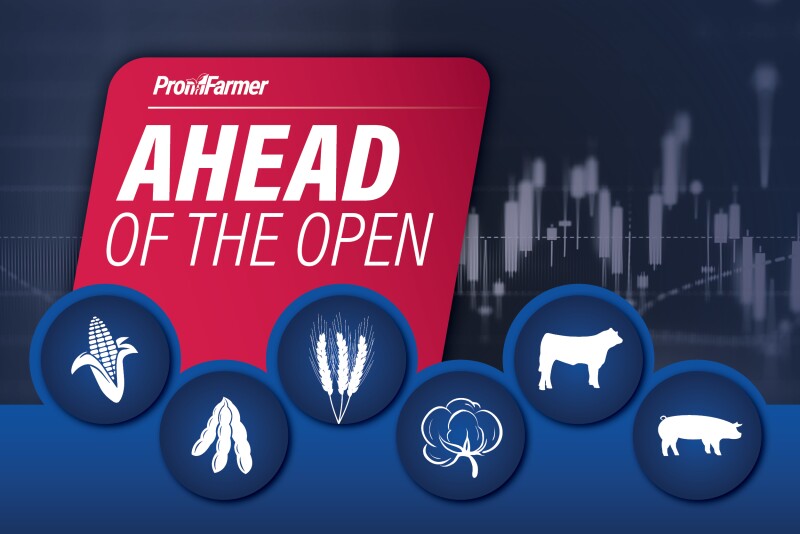GRAIN CALLS
Corn: 3 to 5 cents higher.
Soybeans: 7 to 9 cents higher.
Wheat: Winter wheat 13 to 15 cents higher; HRS 11 to 13 cents higher.
GENERAL COMMENTS: Corn, soybeans and wheat each surged higher in overnight trade with wheat leading the way higher. Each saw modest profit-taking into the break. Corn and wheat are both near recent highs and key resistance. Outside markets are supportive this morning as front-month crude oil futures are modestly higher on corrective buying while the U.S. dollar index is around 550 points lower and near three-month lows.
USDA reported daily sales of 100,000 MT of corn for delivery to Colombia during the 2024-25 marketing year.
A fact sheet (link) from the White House outlined examples of trade policies and actions by other countries that would be targeted via the reciprocal tariff action. A few examples: Brazil: “The U.S. tariff on ethanol is a mere 2.5%. Yet Brazil charges the U.S. ethanol exports a tariff of 18%. As a result, in 2024, the U.S. imported over $200 million in ethanol from Brazil while the U.S. exported only $52 million in ethanol to Brazil.” India: The U.S. has Most Favored Nation (MFN) tariffs on agricultural goods that average 5%, but India has an applied MFN tariff of 39%. The fact sheet also cited motorcycles from India as a case where they charge at 100% tariff while the US level is 2.4%. EU: The European Union was noted for its tariffs on U.S. shellfish, cars and other goods. Bottom line: “A 2019 report found that across 132 countries and more than 600,000 product lines, United States exporters face higher tariffs more than two-thirds of the time,” the release noted.
Brazil’s Energy and Mining Minister Alexandre Silveira said a potential U.S. tariff on Brazilian ethanol would be unreasonable, emphasizing the two countries have historically negotiated ethanol and sugar trade together. His remarks came after President Donald Trump moved to scrap decades-old low tariff rates, raising them to match those of other countries. Silveira argued that for Trump’s plan to be fair and reciprocal, the U.S. would need to eliminate import tariffs on Brazilian sugar.
China issued guidelines to promote biotech cultivation, focusing on gene-editing tools and developing new wheat, corn, and soybean varieties, as part of efforts to ensure food security and boost agriculture technology. The 2024-2028 plan aims to achieve “independent and controllable” seed sources for key crops, with a focus to cultivate high-yield, multi-resistant wheat, corn and high-oil, high-yield soybean and rapeseed varieties. The document pledged to research and develop precision gene-editing tools with independent intellectual property and enhance key cultivation technologies. Additionally, efforts will be made to breed high-performance livestock, including pigs with strong reproductive capacity and high feed conversion rate and disease-resistant broiler chickens.
CORN: March corn futures are trading just below recent highs. Bulls are eyeing initial resistance at $4.98 1/2 before tackling the psychological $5.00 mark. Support comes in at $4.94 1/2 then the 10-day moving average at $4.91 on profit-taking.
SOYBEANS: March soybean futures continued to bounce overnight. Resistance at the 20-day moving average at $10.42 limited overnight gains and is reinforced by the psychological $10.50 mark. Bulls are seeking to hold support at $10.33 1/4 then yesterday’s low of $10.24 on a reversal lower.
WHEAT: March SRW futures surged higher overnight. Stiff resistance stands at the February 7 high of $5.92 1/2 then the psychological $6.00 mark. Support stands at $5.80 then the 10-day moving average at $5.76 1/2 on a reversal.
LIVESTOCK CALLS
CATTLE: Choppy/lower.
HOGS: Choppy/higher.
CATTLE: Live cattle futures and feeders are expected to open with a mostly weaker tone as prices continue to trend lower on the daily bar chart. Discounts to the cash market could limit losses after the open. Traders are anticipating continued weakness in the cash cattle market as packers are struggling with extremely poor margins. The weakness seen in wholesale beef has pushed cutting margins deeper into the red, which could lead to packers cutting slaughter counts even more. Choice cutout fell another $1.86 to $317.40 Thursday while Select rose 70 cents to $309.84, narrowing the Choice/Select spread to a tight $7.56.
HOGS: Lean hog futures are expected to open with a mostly firmer tone, supported by persistent strength in the cash market. April lean hog futures retested prior highs and confirmed support yesterday. Bulls will look to bounce prices off those levels today. The CME lean hog index is up another 98 cents to $88.06 as of Feb. 12, the biggest daily gain in the seasonal climb. February lean hog futures go off the board at noon CT today and will cash settle against today’s index quote when it is released Feb. 19. Pork cutout surged $2.24 to $100.87 Thursday, led by hams and butts, though all cuts except picnics posted gains on the day.

